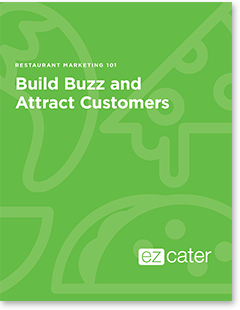Times are tough for caterers and restaurants. There’s more competition than ever. It now takes more to make your food stand out from the crowd. Even if you have the right recipes and team in place, it’s hard to take your business to the next level without a guide. But with a little planning, you can promote your business online. How? Remember that you built your business yourself. You’re no stranger to a little elbow grease. Once the orders start coming in, the value of online marketing for restaurants becomes clear.
From social media to digital content, and everything in between, there’s a lot you can do to market yourself. Online marketing for restaurants is key to improving your catering business. These 30 tips will raise you from a fledgling to an expert marketer in no time.
Beginner Marketing Ideas
1. Build your website. Every small business needs a website. But this can be a challenge, especially if you’re still a newbie to online marketing. But a good website doesn’t have to be super flashy. Find a template you like from a platform like WordPress or Weebly. Keep your website simple. But make sure you’re highlighting what you do that’s different from everyone else. Personalize your content by showing off your team and your dishes.
2. Set up your social media profile. Social media is the place for conversations with your customers. It’s a way to show off new dishes and to receive immediate feedback. But setting up your social media account can feel overwhelming. Do you need Facebook, Twitter, Instagram, Snapchat, and Pinterest accounts, and whichever new platform that just came out? The short answer is no. A tip, for those nervous about online marketing for restaurants, is to start with one platform you’re comfortable with. It’s better to be really good at one platform than mediocre across many. You can always add on as you grow.
3. Update your Google listings. People need to find you. And they won’t if your information isn’t correct online. Do a quick Google search for your business. On the right side of the page, you’ll find the contact information, hours of operation, and maybe even photos of your business. If anything looks incorrect, click “Suggest an Edit” to correct the errors.
4. Encourage customer reviews. Online marketing for restaurants isn’t just about what you’re putting out. Your customers are your best advocates. So you need to find ways to take advantage of that. Make sure your customers know exactly how and where to leave a review. Their words will influence others who come across your restaurant.
5. Offer coupons or discounts. While you’re building your marketing efforts, you may need to offer an incentive to collect email addresses or social media followers. One way to do that is with special coupons or discounts. When someone signs up for your email list, provide a discount on their next offer. Or create special coupons that are only for your followers on Facebook.
6. Set up alerts. When people are talking about you online, you need to know about it. Set up alerts with Google and Bing with your business’s name so you’ll receive notifications any time you’re mentioned. That way you can get a positive review up on your website or shared on social media right away.
7. Reach out to local food writers. And if no one is writing about you (yet), why not look for people in your community that could start? Research the local food writers in your area. Offer them a free tasting so they may write about you. Food writers often have social media networks of their own. Their mentions could drive new business your way.
8. Create creative hashtags. Once your social media efforts are in full swing, create a series of hashtags on your posts. Your customers can use these to tag their photos of your food, or to talk about you on social media. Pick something that’s catchy. Just make sure you research it first. As Forbes points out, not all hashtags are created equally, so make sure you’re choosing the most powerful ones.
9. Update your online menu. Your menu changes. Maybe it’s seasonal. Or maybe it’s every week. But make sure people know what kind of food you offer. Make sure you keep your menu updated on your website and on any other webpage your menu feeds to online. Online marketing for restaurants will never work if customers don’t know about the food you offer.
10. Partner with a catering marketplace. One important way to extend your reach is to partner with a catering marketplace like ezCater. When your name pops up in an ezCater search, who knows how many new customers will find you.
Intermediate Marketing Ideas
11. Start blogging. Once you’ve covered the online marketing basics, it’s time to get serious about content. The easiest entry point is blogging. Add a blog to your website. Talk about food trends, what’s going on in your community, and whatever else you’re interested in. Share your posts through your social media platforms. It will take you a few tries to find your footing. It’s easy to just promote your business, but to become a marketing leader, rather than a follower, find your niche in the space. The less you talk about yourself, the more people will trust you as a thought leader.
12. Utilize social-media management tools. If you’re ready to take your website to the next level, it’s time to upgrade to sophisticated social-media management tools. Tools like Hootsuite, Sprinklr, and TweetDeck allow you to schedule posts in advance and link your platforms together. You’re developing your brand voice, and this will help you to unify that voice across your mediums.
13. Start an email newsletter. Online marketing for restaurants depends on getting the word out about your business. Once you have content to share, it’s time to utilize that email list you’ve been building. You may have been using your email list to offer discounts in the past, but it’s time to start a sustained email campaign. You can decide on the frequency, but a monthly schedule is probably a good start. Send your blog posts, menu updates, and whatever else that will entice your customers to read and share.
14. Respond to reviews. When you get a bad review, it can feel humiliating. You work hard. But you just can’t please everyone. If you’re getting reviews on Facebook, Yelp, or other sites, you can and should respond—to both positive and negative reviews. When you thank your followers for their business or apologize for a challenging order, it’s a nice reminder that you’re a real person. Keep your responses authentic, but avoid getting defensive.
15. Create holiday promotions. Christmas, Valentine’s Day, Halloween…people love the holidays. Use social media to create promotions around holidays that correspond to your best dishes. Maybe it’s a two-for-one special for Valentine’s date night. Or you could give your dishes spooky names around Halloween. Raise awareness of your business by linking to these days.
16. Install the Instagram feed plugin. If people are Instagramming your food—and why wouldn’t they?—adding an Instagram feed plugin to your site is the easiest way to leverage their photos. Every time someone tags your restaurant, the photos automatically feed into your website, so you can show off the best of the best without any added work.
17. Build boosted posts. Boosted posts on Facebook can help you add likes to your page, drive business to menu items, and generally raise awareness of your business. You choose the budget, and you can track your analytics as you go.
18. Create Facebook events. You’ve probably noticed people saying they’re interested in certain events on your Facebook feed. In fact, as Tech Crunch notes, Facebook launched an events-focused app that includes local business. If you’re offering a tasting to the community, or if you have a certain promotion in your restaurant, add an event. People will share it with their networks and the word of mouth will build.
19. Create a mobile-friendly website. Most people are making quick searches on their phones or tablets. If your website isn’t mobile-friendly—and responsive—you should fix it to take advantage of the mobile traffic. Make sure customers can find your menu prices and call or email you with the press of a button.
20. Set up Google Analytics. If you’re not watching the analytics on your website yet, now is the time to set it up. GA will tell you where traffic is coming from and let you know how engaging your content is. Use this information to inform your content calendar and your digital strategy.
Expert Marketing Ideas
21. Update your strategy. By the time you’re an expert, creating online marketing for restaurants probably seems like old hat. But at this point you should update your strategy. Think about all of our digital efforts, including content, social media, and ads. Is your strategy cohesive? Are you speaking in a consistent brand voice across channels? What are your goals to keep the marketing engine moving? Jot down these ideas so you can stay on track.
22. Up your content creation. Now is the time to get serious about your blog. “Once in a while” is not the tempo of an expert marketer. Decide if you want to publish weekly, a few times a week, or even daily. The more SEO-rich content that you create, the more eyes are going to find your business.
22. Bring on influencers. And if you can’t handle the commitment to produce all that content, bring in the cavalry. Bring on influencers who can create content for you, and then promote it to their networks to help fill your content calendar.
23. Use Analytics to pivot your strategy. Set aside time each month to analyze your GA results. Which landing pages or pieces of content on your website are doing really well? Which underperformed? Is traffic coming in from other websites or social media? Figure out what you’re doing well, and then do it better. Figure out what you could do better, and pivot your strategy to make improvements for next time.
24. Launch a paid search campaign. With a paid search campaign you bid on the keywords that are important to you. If you have the best wings in Missouri, you better come up first when someone searches for “best wings in Missouri.” Google AdWords and Bing Ads make it easy to plan the right keywords so you’ll emerge at the top of the searches. And you’ll find that this serves your organic results, too.
25. Buy geo-targeted ads. The key to mobile ads is delivering the content people need when they need it. You can do that with geo-targeting. If you’re trying to entice people to dine at your restaurant, offer a discount code when they enter a certain radius. Or, since you know weddings need caterers, have your ad target customers at the area around an expo or a bridal shop. Just make sure you have the proper landing pages set up so that when customers click on the ad they’re sent to the right spot on your website matching their predicted needs.
26. Create videos. Did you know that, as Social Media Today notes, a user will spend 88 percent more time on a website that features video? That’s worth the investment of creating relevant videos about your business.
28. Create a podcast. A podcast may be another relatively easy way to make your voice heard—quite literally. All you need is a microphone and some basic audio editing software, and you can hit the ground running. Find your niche, and your audience will grow with you.
29. Create an app. Entrepreneur offers six great reasons why you might want to create an app for your business. But, as with other strategies for online marketing for restaurants, it hinges on solving a problem for your customers. If an app will help your base to find you, order more easily, or offer value to your business, then give it a go.
30. Add bots to your page: As Wired reports, there are many future applications of bots in digital marketing. Bots could answer your Facebook messages, and offer menu information, pricing, or hours. Or you can add a customer service bot on your website to answer simple questions. The key to bots is that when they add value, they earn trust.

Looking for more marketing tips? Download our free guide
Want to capture more online catering orders?










